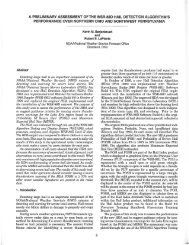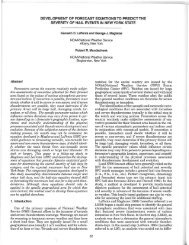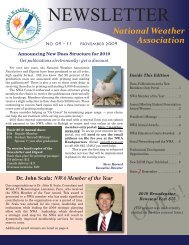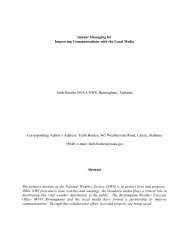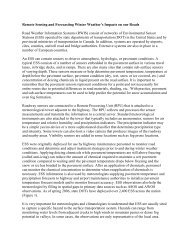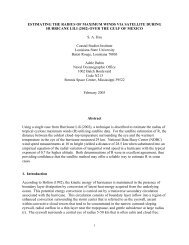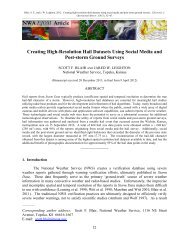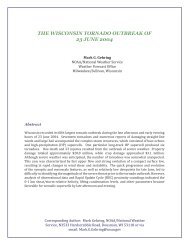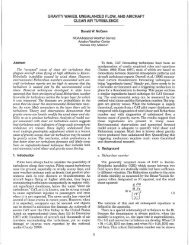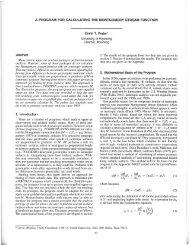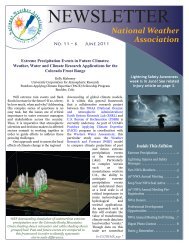ON THE NEED FOR VOLUMETRIC RADAR DATA WHEN ISSUING ...
ON THE NEED FOR VOLUMETRIC RADAR DATA WHEN ISSUING ...
ON THE NEED FOR VOLUMETRIC RADAR DATA WHEN ISSUING ...
You also want an ePaper? Increase the reach of your titles
YUMPU automatically turns print PDFs into web optimized ePapers that Google loves.
Volume 17 Number 4 November, 1992<br />
shaped echo, the magnitude of the pressure fall/rise couplet<br />
and the dramatic change in wind direction indicate that a<br />
mesocyclone may have passed directly over PIB.<br />
The transformation of thunderstorms and their associated<br />
radar echoes into tornadic storms as they interact with preexisting<br />
thermal boundaries has been noted before (Purdom<br />
1976; Maddox et al. 1980; Doswell 1985). As noted in Purdom<br />
(1989) and Moller et al. (1990) , this evolution may well be the<br />
result of the storm' s updraft tilting baroclinically-generated<br />
horizontal vorticity (Klemp 1987), thus enhancing the likelihood<br />
of storm-scale rotation. It is not possible, with the data<br />
sets available for this case, to evaluate the validity of this<br />
hypothesis. Nevertheless, it is noteworthy that the greatest<br />
surface pressure falls and tornadogenesis occurred when the<br />
storm apparently interacted with the warm front (see Fig. 8<br />
for the sUIface analysis nearest the time of the tornado).<br />
The tornado touched down at approximately 1505 about<br />
I n mi (2 km) southeast of PIB (see Fig. I). The radar echo's<br />
area and intensity increased substantially at this time (Fig.<br />
7d). The echo diameter was nearly 25 n mi (46 km) , with a<br />
VIP 51 core approximately 20 n mi (37 km) in diameter. The<br />
size of the VIP 5 core had increased significantly from 1438.<br />
(Note: the reflectivities were reduced temporarily by about<br />
one VIP level at 1447 (Fig. 7b) and 1454 (Fig. 7c), owing to<br />
attenuation from a wet radome.) The tornadic storm at this<br />
time possessed characteristics of an HP supercell, with the<br />
probable mesocyclone thoroughly embedded in precipitation<br />
in the lower levels. The low-level reflectivity gradient had<br />
tightened significantly at this time on both the east and west<br />
sides of this large echo. Thus, it was not possible to determine<br />
the updraft flank of the storm without an upper-level tilt to<br />
display the mid-level overhang signifying the updraft flank.<br />
A pendant (again, not a hook echo) also had redeveloped on<br />
the west side of the storm at 1505 (Fig. 7d) and remained<br />
stationary relative to the echo mass. The pendant persisted<br />
for about 10 minutes before it dissipated. It should be noted<br />
that this storm was located about 75 n mi (139 km) southeast<br />
of JAN at 1505. U sing the standard refractive index, the<br />
beam center height was about 8,000 ft (2.5 km) AGL. The<br />
2.0 0 angular beamwidth for the WSR-57 at 75 nm (139 km)<br />
translates to about a 2.5 n mi (4.6 km) beam diameter at that<br />
distance. Since the larger beam diameter was averaging a<br />
large area of reflectivities that were several thousand feet<br />
above the sUIface, the chances of seeing small-scale, lowlevel<br />
features suggestive of a rotating storm were decreased.<br />
The tornado increased in size and strength as it moved<br />
northeastward at 50 kt (25 m S- I), reaching a maximum width<br />
of I.7 n mi (3. I km) and F4 intensity approximately 3 n mi<br />
(5.5 km) southeast of Laurel, Mississippi at 15 15 (Fig. 7e).<br />
At 15 19 (Fig. 7f) , the echo had taken on a "kidney bean"<br />
shape, which is one shape Moller et al. (1990) have observed<br />
with HP supercells. Another pendant can be seen on the<br />
southeast side of the echo mass. This pendant, unlike those<br />
observed earlier, quickly rotated cyclonically to the northeast<br />
side of the storm by 1530 (Figs. 7g, 7h and 7i). It is<br />
possible that this pendant is associated with a gust front<br />
rotating around the mesocyclone, but without a tilt sequence,<br />
it is (once again) impossible to verify this hypothesis. The<br />
tornado weakened after it moved out of Jones County and<br />
dissipated around 1545.<br />
IThat is. Video Integrator and Processor (VIP) level 5 reflectivity-<br />
50-57 d8Z.<br />
4. Techniques For Examining the Three<br />
Dimensional Structures of Severe<br />
Thunderstorms<br />
This case, plus examination of radar film from other events<br />
including those at other sites, confirms that most NWSOs<br />
and NWSFOs still are not using some type of a tilt scan<br />
strategy, in spite of Lemon's (1980) clear demonstrations of<br />
tilt scanning's operational value. The reasons why operators<br />
are not using a tilt strategy are unclear, but critical warning<br />
information is being missed when the radar is not operated<br />
with volumetric scanning. Integrating a knowledge of the<br />
influential environmental characteristics and identifying<br />
those three-dimensional storm structure features that have<br />
been observed repeatedly with other tornadic storms (e.g.,<br />
Browning 1963; Browning 1965; Lemon 1980) will increase<br />
significantly the likelihood that a tornado warning will be<br />
issued prior to the initial touchdown of a tornado. Many<br />
supercells, particularly those having HP characteristics, do<br />
not consistently display classic low-level echo configurations<br />
(Doswell et al. 1990). Even though the Jones County tornado<br />
briefly displayed a hook echo (not a classic hook), the next<br />
supercell to spawn a killer tornado may not exhibit low-level<br />
features suggestive of a tornadic storm. A tilt scan, such as<br />
the Lemon Technique (1980) , however, will increase the<br />
likelihood that a tornado warning will be issued prior to the<br />
initiation of the event. In this section, a brief review of the<br />
three-dimensional features of severe and tornadic thunderstorms<br />
are presented. Also, tilt strategies for use with conventional<br />
radars and the WSR-88D are included.<br />
4.1 Three-Dimensional Features Suggestive of<br />
Severe Storms<br />
Lemon (1980) used the observed relationship between the<br />
storm top, mid-level and low-level echoes as an indicator of<br />
the updraft strength in a storm. With weak, unsustained<br />
updrafts, the precipitation produced by the updraft transforms<br />
the cell into predominately downward motion and the<br />
storm dies rapidly. This results in a storm where the top, midlevel<br />
and low-level reflectivity cores are aligned vertically.<br />
There is no significant low-level gradient and the mid-level<br />
overhang, if any, is negligible.<br />
With a stronger updraft, the storm top shifts away from<br />
the low-level reflectivity core, moving over the strengthening<br />
low-level reflectivity gradient on the storm's updraft flank.<br />
The tightening low-level gradient results, in part, from the<br />
size sorting of rain and hail by the strong updraft and the<br />
vertical wind shear in the environment (which is an important<br />
ingredient in the strengthening of the updraft and determining<br />
the consequent echo shape). The mid-level echo overhang<br />
forms in part because precipitation develops higher within<br />
the storm' s updraft, resulting in an area of weak or no radard~tectable<br />
precipitation below the mid-level echo. Strong<br />
dIvergence at the storm top also spreads precipitation laterally,<br />
further contributing to the WER development. The presence<br />
of the mid-level overhang and storm top located over<br />
the low-level gradient suggests that the updraft is strong<br />
enough to produce severe weather (at least large hail, and<br />
possibly strong sllIface wind gusts). A severe thunderstorm<br />
warning should be seriously considered when a storm exhibits<br />
this three-dimensional structure, especially in unstable<br />
environments.<br />
Four reflectivity slices at different elevation angles at 2304<br />
on 26 April 1991 from the Twin Lakes (near Oklahoma City,<br />
9



